
Those black and white birds on Australia’s east coast
This guide should help you identify some of those common black and white birds on
Australia’s east coast. I’ll start with the biggest bird in this group and
then work my way down to the smallest.

The thick cluster of neck feathers (called hackles) help
identify this bird as an Australian Raven.
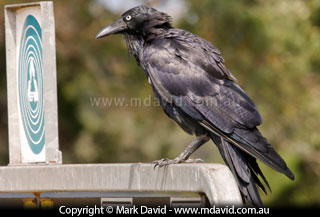
Australian Raven
Corvus coronoides
The only white you’ll see on these shiny black birds is their eye (which
is also blue). The base of their feathers is
grey, but you’re not likely to see that. One feature of the
Australian Raven which you are likely to see is the thick, long, beard-like clump
of feathers on its throat, called hackles. These are impressive, big
birds with a call that sounds something like ‘arrrr, arrr, arrrrrrrr’.
That sound could almost be mistaken for human. More information
here.
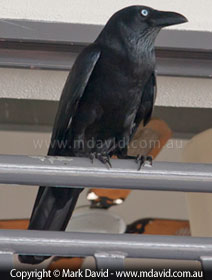
Torresian Crow
Corvus orru
Like the Australian Raven, these birds have a white eye and are covered all over with
black feathers, but the hackles (neck feathers) are much less prominent and the bases of
the feathers are white. Also, they aren’t as big as the Australian Raven.
These are the birds you’re likely to see across an area stretching along the
Queensland coast and into northern NSW. You might also see them in Western Australia,
Northern Territory and the northern-most bits of South Australia
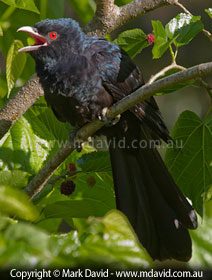
Common Koel
Eudynamys orientalis
Also sometimes called the Koel Cuckoo. The male is an impressive black bird with bright
red eyes. Females are patterned brown and white. There’s a good chance
you’ll hear them before you see them due to their extremely loud call. These
birds live in New Guinea and far northern Australia during winter and then fly south
to breed in spring. They lay their eggs in other birds’ nests (birds
of other species) and then take off, leaving the host birds to do all the work raising the chicks.
I don’t want to suggest the Koels have it all that easy though, because flying
from New Guinea to Sydney and back doesn’t sound like light work.
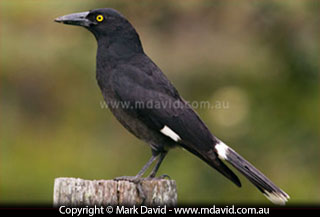

Pied Currawong
Strepera graculina
The word ‘Pied’ in its name tells you this bird is more than just black.
Those little flashes of white on the wings and tail tell you you’re not looking at
a raven or a crow. A bright yellow eye and a bill which is slightly hooked at the end also help to
identify these birds.
Currawongs will eat berries, insects and other small animals. They are even known to
sometimes take the young from other birds’ nests. Perhaps that’s why I’ve
seen them being harassed and chased by smaller birds like Willy Wagtails.
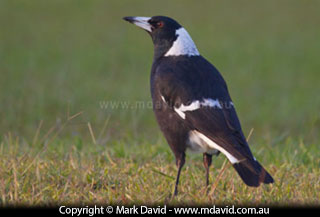
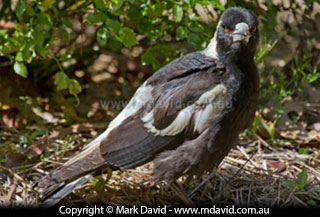
Australian Magpie
Gymnorhina tibicen
That’s the adult bird in the first photo and that one with lighter feathers in
the next photo is a young one. So if you see one of the young ones you’ll almost always
see some adult birds nearby. These birds are often seen walking around in a small
family group feeding on the ground.
Look for the white on the back of the neck and a beak which is bluish-grey tipped with
black.
More photos and information about Magpies here.
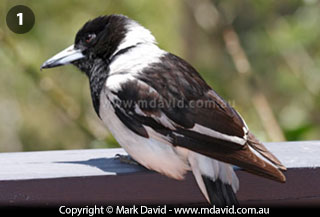
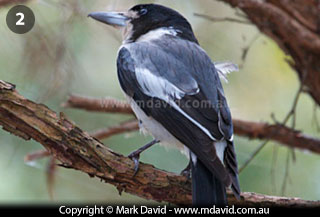
Butcherbird
Number 1 is a Pied Butcherbird (Cracticus nigrogularis) and number 2 is a
Grey Butcherbird (Cracticus torquatus). You could easily mistake these birds
for Magpies until you notice that they’re smaller and stockier and have a clearly
hooked beak. These birds have a beautiful call and it’s worth pausing to listen when they’re in full song.
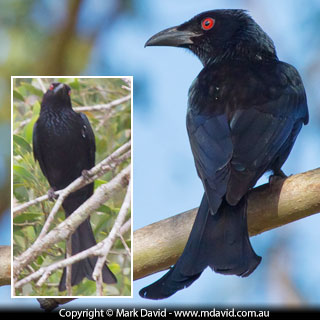
Spangled Drongo
Dicrurus bracteatus
In Australia the word drongo means a no-hoper, an idiot, a fool… So when people
ask me what kind of bird this is and I say it’s a Spangled Drongo it always seems to
get a laugh.
However the Spangled Drongo is a handsome bird with a very distinctive mix of red eye,
forked tail, glossy black feathers and greenish ‘spangles’ on its chest. It’s
a very capable flier too, catching insects in mid-air. If only they’d given it a more
dignified name. Like perhaps Red-eyed Drongo.

Black-faced Cuckoo-shrike
Coracina novaehollandiae
Here’s a bird you might see in Australia’s west as well as the east. The bird
is grey on its back and paler grey underneath, but it’s the black mask and throat
that really draws attention and gives its identity away. A small expanse of white plumage
on the undercarriage just barely qualifies it for entry into this listing of black and white birds.
There’s actually another bird called a Masked Woodswallow which kinda, sorta looks
the same. But that bird has a clear white crescent around the base of the black mask. By contrast, you’ll see
that this bird has the black mask ending in grey plumage.
They feed on small invertebrates and are quite common.
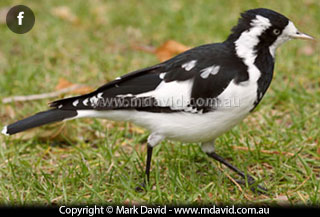
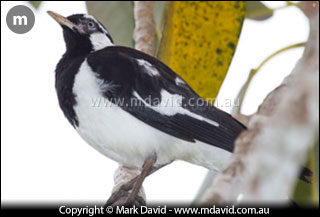
Magpie Lark
Grallina cyanoleuca
At first glance these birds almost look like miniature Magpies. They have a much smaller
beak than the Magpie, but like the Magpies they will often be seen wandering around on
the ground. The bird in the photo marked with an “f” is a female. You can tell that by her white face
and throat. The male, which in a fit of creativity I’ve marked with an “m”, has the black face and throat.

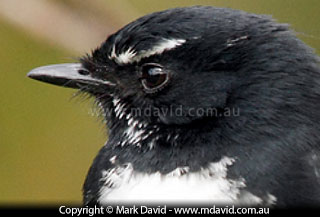
Willie Wagtail
Rhipidura leucophrys
Willie Wagtails will often be seen hopping about a lawn, swishing their tails
from side to side. I enjoy having these birds around. They seem to always be
lively. They have two very different calls — an alarm call which is a sort
of metallic chkkttt chkkttt chkktt sounding like someone shaking a jar
full of nails, or a sweet song-bird call about as unlike a jar of nails as you
could imagine. That song-bird call, by the way, sometimes goes on and on at night.
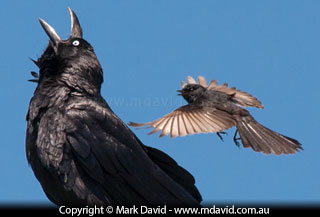
As much as I like them I’m glad they’re not the size of a dog
because they can be a little bit aggressive and quite fearless too. I often see
them chasing or harassing much bigger birds like Ravens, as is happening in this photo,
and occasionally one will stand its ground and give me an indignant blast of chkkttt chkkttt
too. The one in the first photo is looking a bit wind-blown but normally they are
a sleek-looking bird. Look for the black-all-over head and their crazy white
‘eyebrow’. Size is about 20cm. These birds can be found all over
Australia.
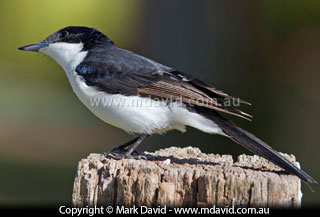
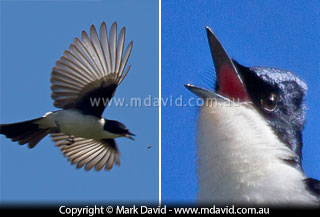
Restless Flycatcher
Myiagra inquieta
This bird is easily mistaken for a Willie Wagtail. It looks similar, is about the same
size, and often hangs around in the same area. But there are differences which make
identification easy.
See how the bottom half of the bird’s head is white, whereas the Willie
Wagtail’s head is black all around. That’s the bit I look for. The
Restless Flycatcher has a bluish tinge to its head too, and sometimes
you’ll notice a bit of a crest.
They have an impressive ability to ‘hawk’, which means to leave
their perch in the tree and snatch their prey in the air. And another name for
hawking is flycatching. The ‘restless’ part of their name is
well deserved too. They’re an active bird, often hovering around the foliage of
trees or moving from one tree to another. In one of these photos we see
a Restless Flycatcher catching an insect in mid-air. And yes, it did
catch that insect.
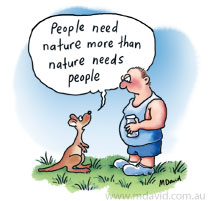

Birds

Reptiles

Plants

Insects and spiders

Nature words

Other stuff


























